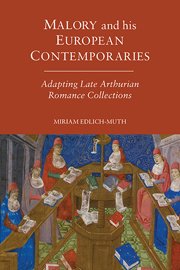Book contents
- Frontmatter
- Dedication
- Contents
- Colophon
- Acknowledgements
- Introduction
- 1 The Adaptation Process
- 2 Style and Narrative Strategy
- 3 Chronological and Genealogical Structures in the Morte Darthur, the Buch der Abenteuer and the Tavola Ritonda
- 4 Narrative Plot Development in the Morte Darthur, the Buch der Abenteuer and the Tavola Ritonda
- 5 ‘The Best Knight in the World’: Adapting Character Constellations
- Conclusion
- Appendix: Note on the Texts and Manuscripts
- Bibliography
- Index
- Arthurian Studies
2 - Style and Narrative Strategy
Published online by Cambridge University Press: 05 March 2014
- Frontmatter
- Dedication
- Contents
- Colophon
- Acknowledgements
- Introduction
- 1 The Adaptation Process
- 2 Style and Narrative Strategy
- 3 Chronological and Genealogical Structures in the Morte Darthur, the Buch der Abenteuer and the Tavola Ritonda
- 4 Narrative Plot Development in the Morte Darthur, the Buch der Abenteuer and the Tavola Ritonda
- 5 ‘The Best Knight in the World’: Adapting Character Constellations
- Conclusion
- Appendix: Note on the Texts and Manuscripts
- Bibliography
- Index
- Arthurian Studies
Summary
Apart from the sheer length of Arthurian chronographies, one of the most striking aspects of the works in this study is the diversity of styles and narrative strategies the authors and adaptors deploy. These strategies are to some degree a reflection of the process of adapting sources outlined in Chapter 1. Nonetheless, far from simply being predictable solutions to the wide-ranging stylistic demands of their assorted sources and plot-lines, the adaptors' choices of narrative technique and self-presentation clearly reflect a wide range of literary aims and abilities. This chapter will examine the five adaptations in turn and use comparable passages of the works as a basis for discussing the stylistic execution of the authors concerned.
The literary merits of all of the works in question have already been discussed extensively: the Tavola, the Gonnot, the Dutch Lancelot and the Buch by the studies of Delcorno Branca, Pickford, Besamusca and Bastert, respectively, and the Morte by critics ranging from Field to Jeremy Smith. What this chapter will do therefore is offer a fresh perspective on the texts, by examining how the adaptors handle three key stylistic features of each text: first, the introduction of new chapters or adventures; second, the self-presentation of the author or narrator figure; and third, the style of descriptive writing.
Of the five texts, the two verse collections, the Buch and the Lancelot, are the most stylistically complex and the two adaptors accomplish the feat of creating a lengthy verse chronography with varying success in terms of consistency and readability.
- Type
- Chapter
- Information
- Malory and his European ContemporariesAdapting Late Arthurian Romance, pp. 38 - 61Publisher: Boydell & BrewerPrint publication year: 2014



